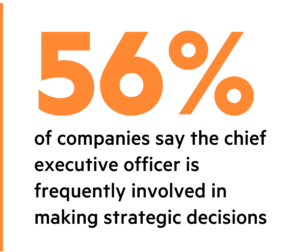The customer journey: How has B2B buying changed?
Gareth Lofthouse
The days when strategic business was awarded on the basis of strong personal relationships or impressive sales presentations are long gone.
Today, mega trends, such as sustainability, digitalisation and the shift to hybrid working, are propelling business transformation. But these are complex, challenging issues. So it’s easy to see why organisations are looking for help with ideas, insights and expertise.
To be competitive, companies need to show that they are genuine thought leaders in these areas. And as our latest research shows, this needs to happen long before the formal tendering process leads to a commercial conversation.
It’s this new level of complexity that led us to carry out the research on the customer journey to sense-check where B2B audiences are at the moment in terms of how they view content and thought leadership specifically as part of the buying process.
The findings highlight some important changes marketers need to be aware of.
Harder to win – and easier to lose
The research reveals the level of rigour that is applied to the selection process has increased dramatically over the last few years.

86% of the senior business executives we surveyed say they are ‘professionalising’ the purchasing process by scrutinising companies far more thoroughly and putting more contracts through tender than ever before.
Add to that the fact that 77% of respondents say that they re-tender on major enterprise deals at least every two years and 44% do so every year and this reflects a seismic shift in the buying landscape.
This means that companies need to demonstrate they have thought-provoking, credible ideas in the areas that matter most to their customers if they are to compete for and win business today.
It isn’t about publishing lots of academic, high-brow insight. But instead, business audiences want content that communicates ideas and demonstrates that your business has relevant, interesting things to say on how you can help them to solve their fundamental challenges.
The research also confirms that this needs to happen long before the formal tendering process leads to a sales interaction. And if you are the incumbent, you now need to defend and prove your value to your customers even more than before.
A bigger team to impress
The second important change the findings uncover is that B2B buyer groups are getting larger and more complex. On average, nine buyers are involved in decision making within organisations, particularly for enterprise levels of investment, which our research focuses on specifically.

Many of those decision makers are C-suite level and above. But be careful not to think of leaders as a single, homogeneous group – with mutual priorities and interests.
As marketers and thought leadership planners, we need to be more thoughtful about catering to those individual roles with content and insight. Read more about the needs of the nine most common roles involved in the buying process here.
Values matter
The third important area the research sheds light on is the criteria business executives are using to select strategic partners, particularly when it comes to a company’s values.
Business leaders want to see substance, not misleading, false information. Principles and ethics, such as sustainability and ESG, are a significant factor for customers in weighing up which companies to work with. In fact, they are more important than more traditional areas of competition, such as product innovation and price.

Win them over early…
Finally, the research shows strong support for the notion that new buyers and current customers will weigh you up long before you get a sales team through their door.
Customers will assess your suitability very early on in the process, based on the criteria above – at which point you may not even be aware they even exist!
But they need to know that you do. Our research also confirms that thought leadership has an important role to play in this evaluation.
Business leaders use thought leadership to assess innovative thinking, your vision for the future and the quality of your talent.
But beware of me-too ‘thought leadership’. Real thought leadership is differentiated insight. There’s little that puts C-suite audiences off more than research findings that are predictable and lack interest.
Focus on getting the basics right – which is as simple as picking the right headline. Your big idea or most compelling insight needs to land with your audience in a matter of seconds. So find the hook that will resonate best. Find topics that resonate across the board agenda in most of your customer base, and think about how you can tailor the message.
… and make it memorable
Talk the language of the individual you want to read it. Make it personal. Make it relevant. Consider how your insight will help them to make better decisions and help achieve their goals.
But also package it in a way that it’s lively, provocative and entertaining. Very often, this is where corporate thought leadership falls down.
If you say something smart which you know will resonate and you can back it up with data and present it in an interesting or unusual but stimulating way, then you will always outplay the vast majority of your competition.
Explore all the insights in depth and download the report for full recommendations here.
Speak to the team
We’ll help you to navigate and overcome any challenges you currently face and learn how to get more out of your content.
Book a meeting
About the author: Gareth Lofthouse
Gareth is our chief revenue officer and manages our growing commercial team as we continue to advise some of the biggest B2B companies in the world on their thought leadership strategy. He works with clients to design thought leadership that delivers maximum commercial impact, both in terms of building client relationships and improving brand visibility.
Before joining FT Longitude, he spent nine years as editorial director for EMEA at the Economist Intelligence Unit (EIU). Gareth was instrumental in building the EIU’s thought leadership and survey business, and he has overseen hundreds of custom projects for the Economist’s clients across a range of industries and subject areas. Before that, Gareth led an editorial and creative team for a PR and marketing agency. He has also held several senior editorial positions in business and technology publishing.
 |
Tel:
+44 (0)20 7873 4770
|
Tel:
+44 (0)20 7873 4770



